Auditing Cadmium Enterprise: Financial Statement Analysis and Findings
VerifiedAdded on 2023/06/06
|16
|2597
|408
Report
AI Summary
This report delves into the auditing functions performed on Cadmium Enterprise, a proprietorship firm, examining various aspects of auditing within a business environment. The primary focus is identifying material misstatements through the analysis of the company's trial balance, employing tr...
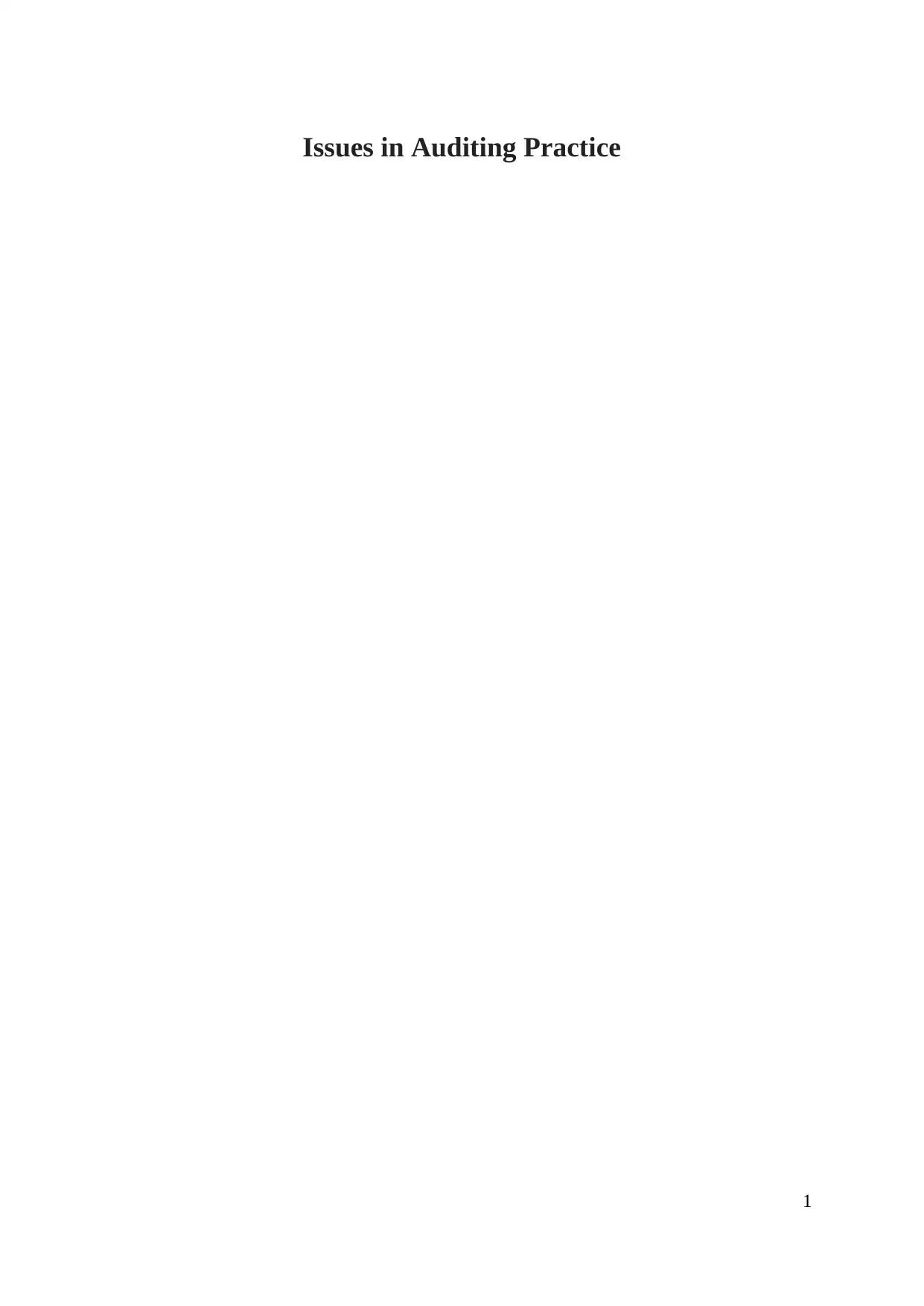
Issues in Auditing Practice
1
1
Paraphrase This Document
Need a fresh take? Get an instant paraphrase of this document with our AI Paraphraser
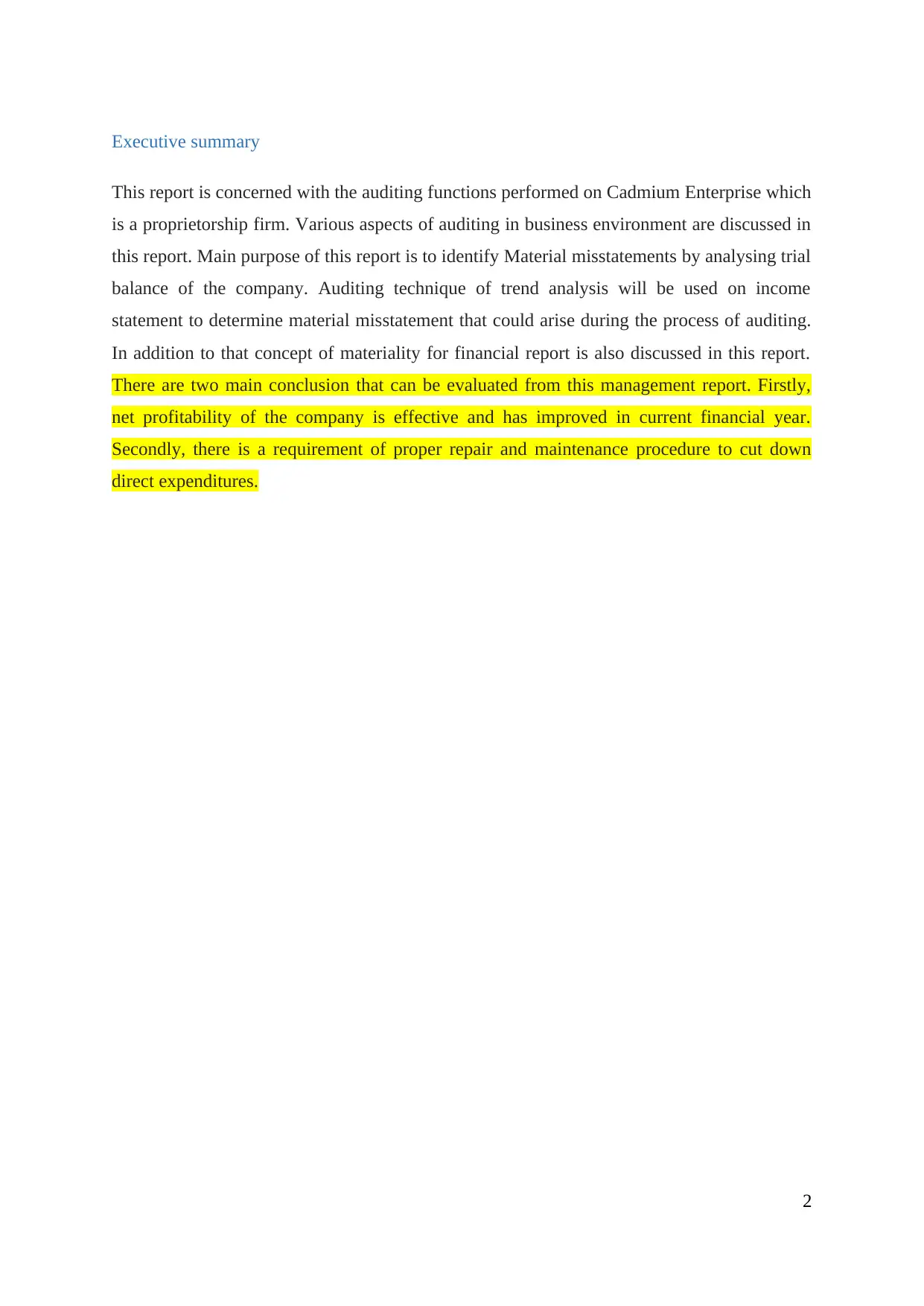
Executive summary
This report is concerned with the auditing functions performed on Cadmium Enterprise which
is a proprietorship firm. Various aspects of auditing in business environment are discussed in
this report. Main purpose of this report is to identify Material misstatements by analysing trial
balance of the company. Auditing technique of trend analysis will be used on income
statement to determine material misstatement that could arise during the process of auditing.
In addition to that concept of materiality for financial report is also discussed in this report.
There are two main conclusion that can be evaluated from this management report. Firstly,
net profitability of the company is effective and has improved in current financial year.
Secondly, there is a requirement of proper repair and maintenance procedure to cut down
direct expenditures.
2
This report is concerned with the auditing functions performed on Cadmium Enterprise which
is a proprietorship firm. Various aspects of auditing in business environment are discussed in
this report. Main purpose of this report is to identify Material misstatements by analysing trial
balance of the company. Auditing technique of trend analysis will be used on income
statement to determine material misstatement that could arise during the process of auditing.
In addition to that concept of materiality for financial report is also discussed in this report.
There are two main conclusion that can be evaluated from this management report. Firstly,
net profitability of the company is effective and has improved in current financial year.
Secondly, there is a requirement of proper repair and maintenance procedure to cut down
direct expenditures.
2
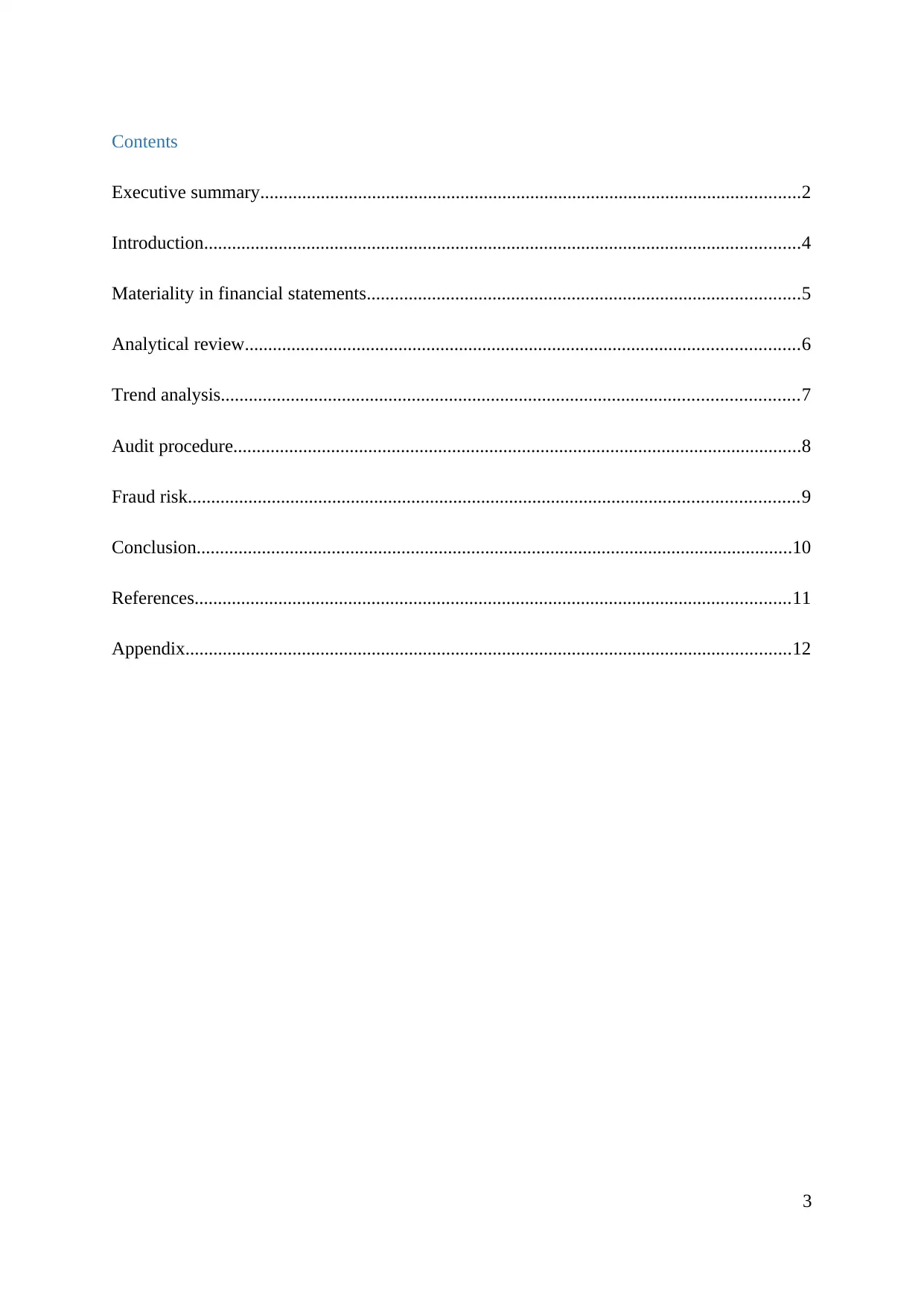
Contents
Executive summary....................................................................................................................2
Introduction................................................................................................................................4
Materiality in financial statements.............................................................................................5
Analytical review.......................................................................................................................6
Trend analysis............................................................................................................................7
Audit procedure..........................................................................................................................8
Fraud risk...................................................................................................................................9
Conclusion................................................................................................................................10
References................................................................................................................................11
Appendix..................................................................................................................................12
3
Executive summary....................................................................................................................2
Introduction................................................................................................................................4
Materiality in financial statements.............................................................................................5
Analytical review.......................................................................................................................6
Trend analysis............................................................................................................................7
Audit procedure..........................................................................................................................8
Fraud risk...................................................................................................................................9
Conclusion................................................................................................................................10
References................................................................................................................................11
Appendix..................................................................................................................................12
3
⊘ This is a preview!⊘
Do you want full access?
Subscribe today to unlock all pages.

Trusted by 1+ million students worldwide

Introduction
The function of auditing has various advantages for internal as well as external stakeholders
of a company. Main objective of an auditor is to identify material misstatements, frauds and
errors in financial statements of a particular company. It is not possible for every
shareholders to examine the financial statements of the company as they might not have
sufficient knowledge to examine and analyse financial statements (Louwers et.al, 2015). This
is the reason that shareholders and management of the company appoints auditor for
examination of financial statements and give their Independent and objective views on
financial position of the company. Important that an auditor implement due diligence and
avoid gross negligence while conducting his or her roles and responsibilities as an auditor
(Cohen and Simnett, 2014). We have prepared this report for Cadmium Enterprises which is
an individual organisation. Audit is required to be conducted and specific points are to be
discussed in this report with respect to trial balance given energy scenario. As an auditor we
have also discussed the fraud risk and material misstatements in the trail balance of the
company. Possible areas of material risk are account receivable, inventory, repair and
Maintenance and sales. We should include these factors in key auditor matters statement
which will be then discussed with those charged with governance.
4
The function of auditing has various advantages for internal as well as external stakeholders
of a company. Main objective of an auditor is to identify material misstatements, frauds and
errors in financial statements of a particular company. It is not possible for every
shareholders to examine the financial statements of the company as they might not have
sufficient knowledge to examine and analyse financial statements (Louwers et.al, 2015). This
is the reason that shareholders and management of the company appoints auditor for
examination of financial statements and give their Independent and objective views on
financial position of the company. Important that an auditor implement due diligence and
avoid gross negligence while conducting his or her roles and responsibilities as an auditor
(Cohen and Simnett, 2014). We have prepared this report for Cadmium Enterprises which is
an individual organisation. Audit is required to be conducted and specific points are to be
discussed in this report with respect to trial balance given energy scenario. As an auditor we
have also discussed the fraud risk and material misstatements in the trail balance of the
company. Possible areas of material risk are account receivable, inventory, repair and
Maintenance and sales. We should include these factors in key auditor matters statement
which will be then discussed with those charged with governance.
4
Paraphrase This Document
Need a fresh take? Get an instant paraphrase of this document with our AI Paraphraser
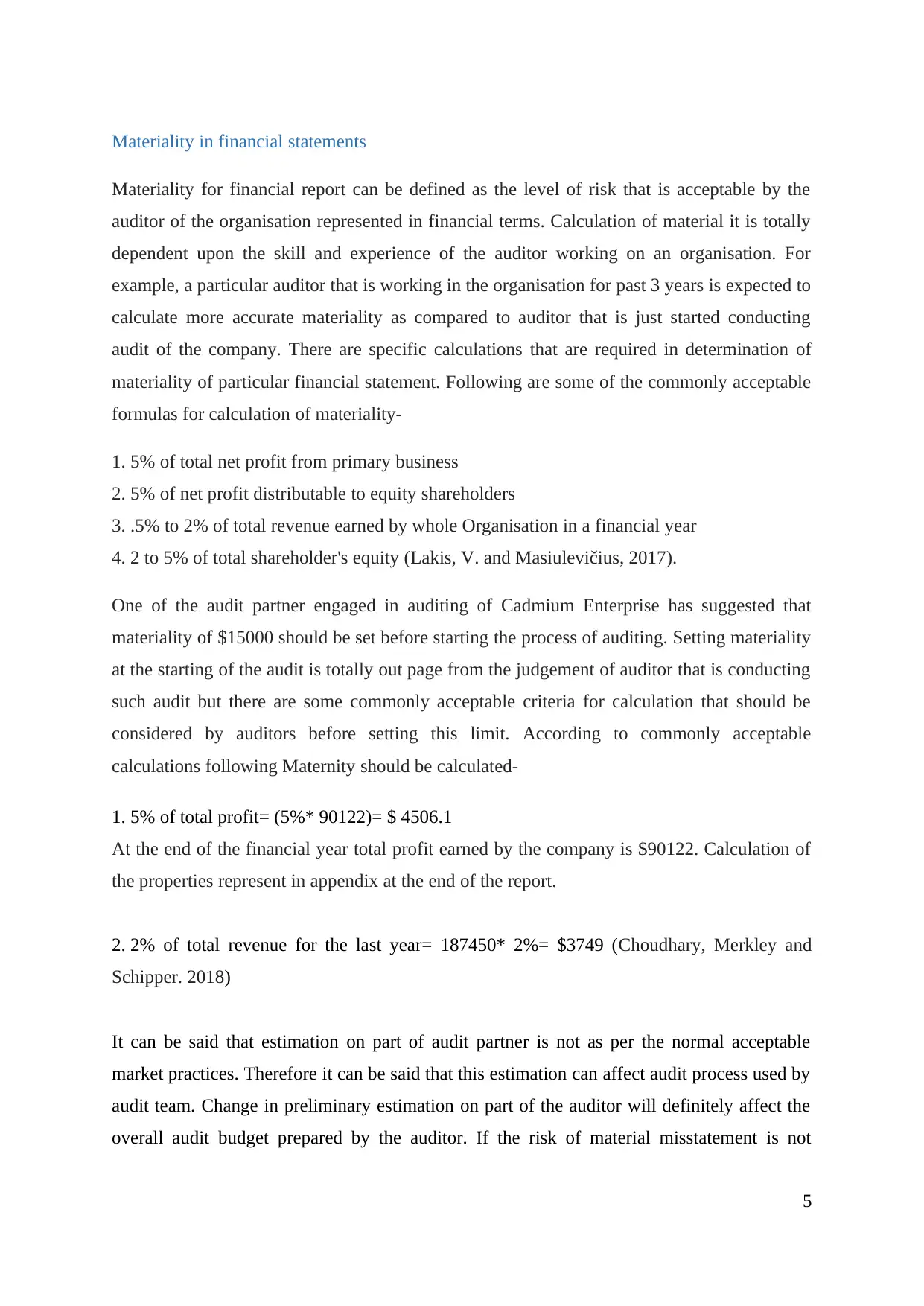
Materiality in financial statements
Materiality for financial report can be defined as the level of risk that is acceptable by the
auditor of the organisation represented in financial terms. Calculation of material it is totally
dependent upon the skill and experience of the auditor working on an organisation. For
example, a particular auditor that is working in the organisation for past 3 years is expected to
calculate more accurate materiality as compared to auditor that is just started conducting
audit of the company. There are specific calculations that are required in determination of
materiality of particular financial statement. Following are some of the commonly acceptable
formulas for calculation of materiality-
1. 5% of total net profit from primary business
2. 5% of net profit distributable to equity shareholders
3. .5% to 2% of total revenue earned by whole Organisation in a financial year
4. 2 to 5% of total shareholder's equity (Lakis, V. and Masiulevičius, 2017).
One of the audit partner engaged in auditing of Cadmium Enterprise has suggested that
materiality of $15000 should be set before starting the process of auditing. Setting materiality
at the starting of the audit is totally out page from the judgement of auditor that is conducting
such audit but there are some commonly acceptable criteria for calculation that should be
considered by auditors before setting this limit. According to commonly acceptable
calculations following Maternity should be calculated-
1. 5% of total profit= (5%* 90122)= $ 4506.1
At the end of the financial year total profit earned by the company is $90122. Calculation of
the properties represent in appendix at the end of the report.
2. 2% of total revenue for the last year= 187450* 2%= $3749 (Choudhary, Merkley and
Schipper. 2018)
It can be said that estimation on part of audit partner is not as per the normal acceptable
market practices. Therefore it can be said that this estimation can affect audit process used by
audit team. Change in preliminary estimation on part of the auditor will definitely affect the
overall audit budget prepared by the auditor. If the risk of material misstatement is not
5
Materiality for financial report can be defined as the level of risk that is acceptable by the
auditor of the organisation represented in financial terms. Calculation of material it is totally
dependent upon the skill and experience of the auditor working on an organisation. For
example, a particular auditor that is working in the organisation for past 3 years is expected to
calculate more accurate materiality as compared to auditor that is just started conducting
audit of the company. There are specific calculations that are required in determination of
materiality of particular financial statement. Following are some of the commonly acceptable
formulas for calculation of materiality-
1. 5% of total net profit from primary business
2. 5% of net profit distributable to equity shareholders
3. .5% to 2% of total revenue earned by whole Organisation in a financial year
4. 2 to 5% of total shareholder's equity (Lakis, V. and Masiulevičius, 2017).
One of the audit partner engaged in auditing of Cadmium Enterprise has suggested that
materiality of $15000 should be set before starting the process of auditing. Setting materiality
at the starting of the audit is totally out page from the judgement of auditor that is conducting
such audit but there are some commonly acceptable criteria for calculation that should be
considered by auditors before setting this limit. According to commonly acceptable
calculations following Maternity should be calculated-
1. 5% of total profit= (5%* 90122)= $ 4506.1
At the end of the financial year total profit earned by the company is $90122. Calculation of
the properties represent in appendix at the end of the report.
2. 2% of total revenue for the last year= 187450* 2%= $3749 (Choudhary, Merkley and
Schipper. 2018)
It can be said that estimation on part of audit partner is not as per the normal acceptable
market practices. Therefore it can be said that this estimation can affect audit process used by
audit team. Change in preliminary estimation on part of the auditor will definitely affect the
overall audit budget prepared by the auditor. If the risk of material misstatement is not
5
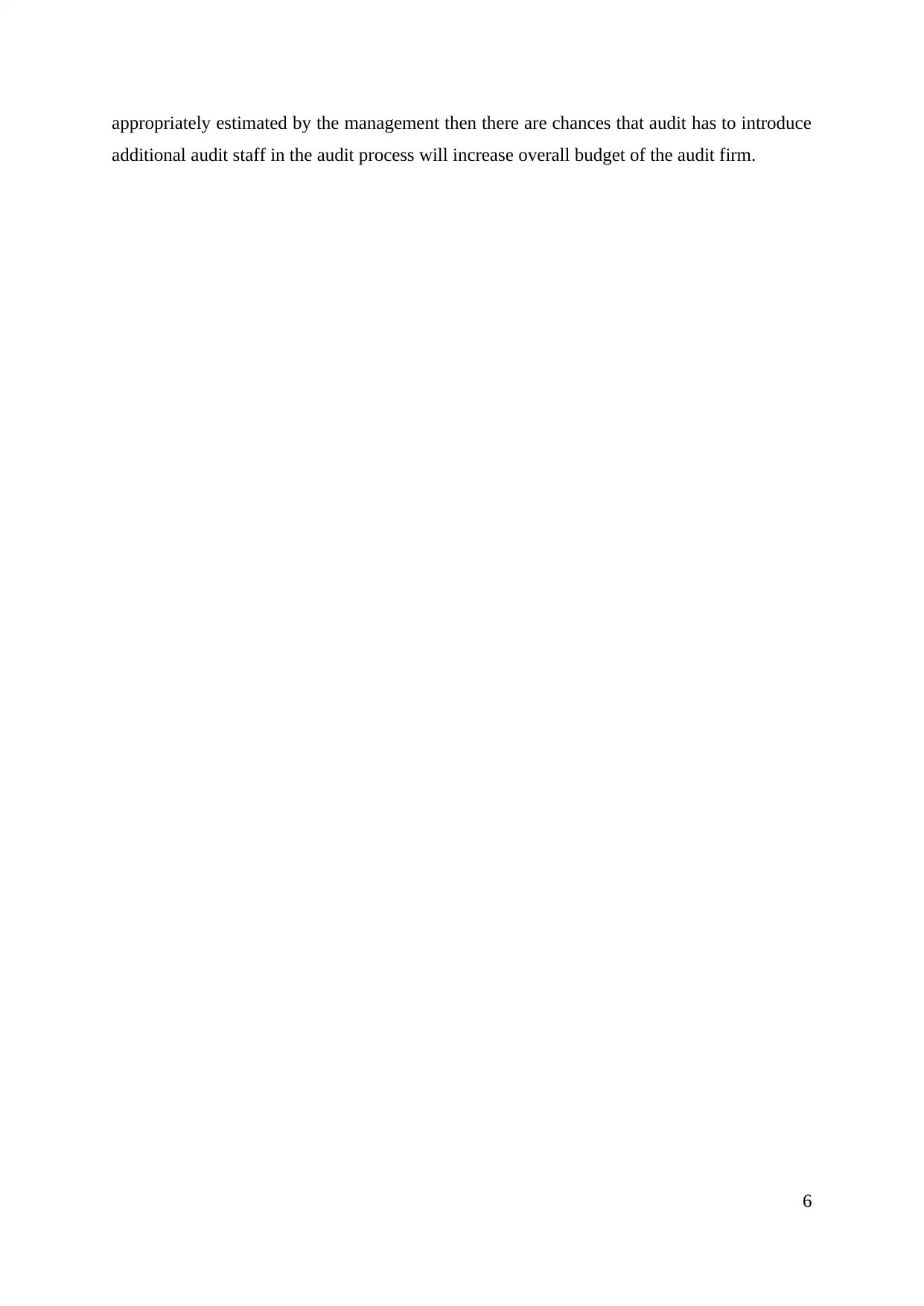
appropriately estimated by the management then there are chances that audit has to introduce
additional audit staff in the audit process will increase overall budget of the audit firm.
6
additional audit staff in the audit process will increase overall budget of the audit firm.
6
⊘ This is a preview!⊘
Do you want full access?
Subscribe today to unlock all pages.

Trusted by 1+ million students worldwide
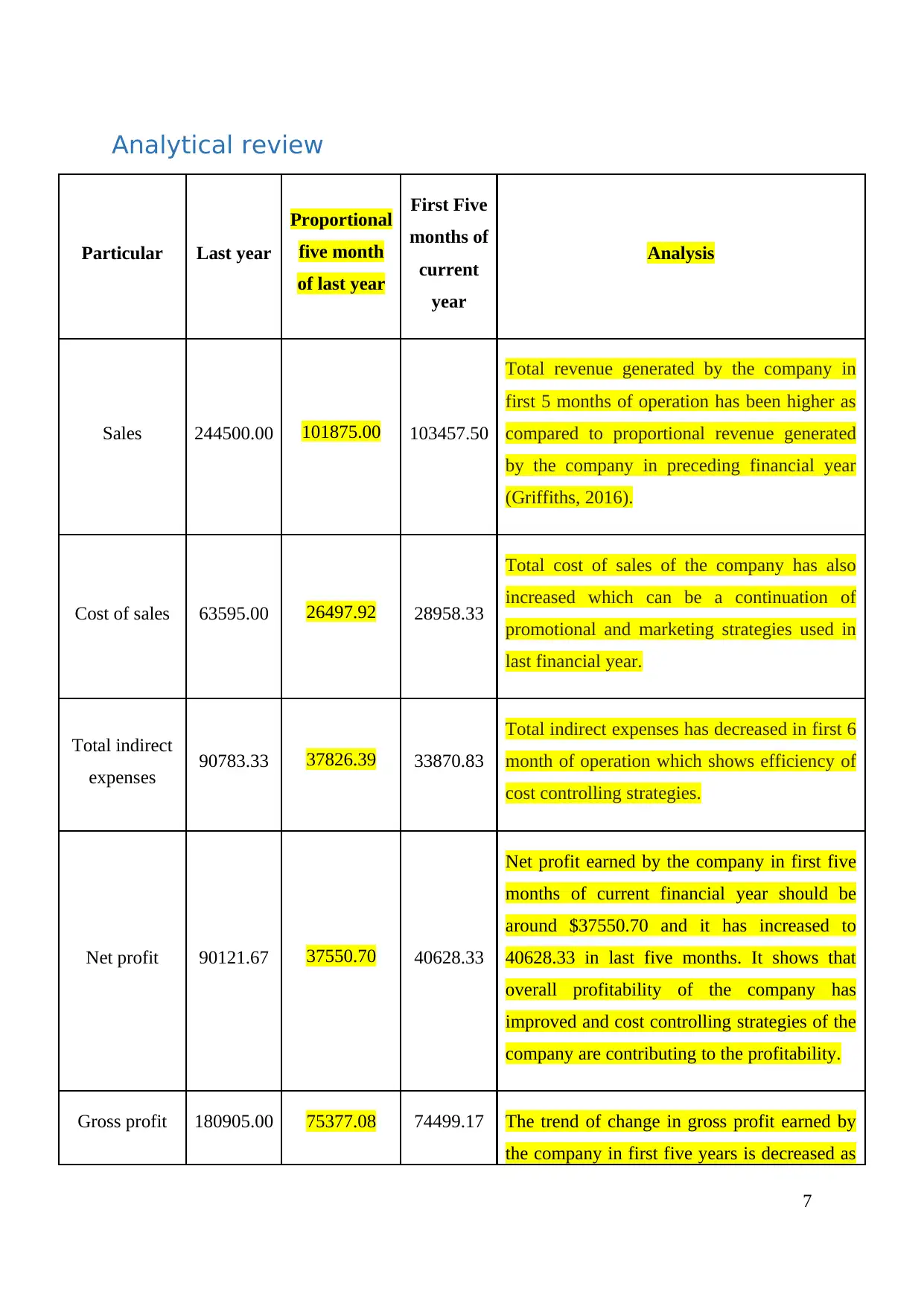
Analytical review
Particular Last year
Proportional
five month
of last year
First Five
months of
current
year
Analysis
Sales 244500.00 101875.00 103457.50
Total revenue generated by the company in
first 5 months of operation has been higher as
compared to proportional revenue generated
by the company in preceding financial year
(Griffiths, 2016).
Cost of sales 63595.00 26497.92 28958.33
Total cost of sales of the company has also
increased which can be a continuation of
promotional and marketing strategies used in
last financial year.
Total indirect
expenses 90783.33 37826.39 33870.83
Total indirect expenses has decreased in first 6
month of operation which shows efficiency of
cost controlling strategies.
Net profit 90121.67 37550.70 40628.33
Net profit earned by the company in first five
months of current financial year should be
around $37550.70 and it has increased to
40628.33 in last five months. It shows that
overall profitability of the company has
improved and cost controlling strategies of the
company are contributing to the profitability.
Gross profit 180905.00 75377.08 74499.17 The trend of change in gross profit earned by
the company in first five years is decreased as
7
Particular Last year
Proportional
five month
of last year
First Five
months of
current
year
Analysis
Sales 244500.00 101875.00 103457.50
Total revenue generated by the company in
first 5 months of operation has been higher as
compared to proportional revenue generated
by the company in preceding financial year
(Griffiths, 2016).
Cost of sales 63595.00 26497.92 28958.33
Total cost of sales of the company has also
increased which can be a continuation of
promotional and marketing strategies used in
last financial year.
Total indirect
expenses 90783.33 37826.39 33870.83
Total indirect expenses has decreased in first 6
month of operation which shows efficiency of
cost controlling strategies.
Net profit 90121.67 37550.70 40628.33
Net profit earned by the company in first five
months of current financial year should be
around $37550.70 and it has increased to
40628.33 in last five months. It shows that
overall profitability of the company has
improved and cost controlling strategies of the
company are contributing to the profitability.
Gross profit 180905.00 75377.08 74499.17 The trend of change in gross profit earned by
the company in first five years is decreased as
7
Paraphrase This Document
Need a fresh take? Get an instant paraphrase of this document with our AI Paraphraser
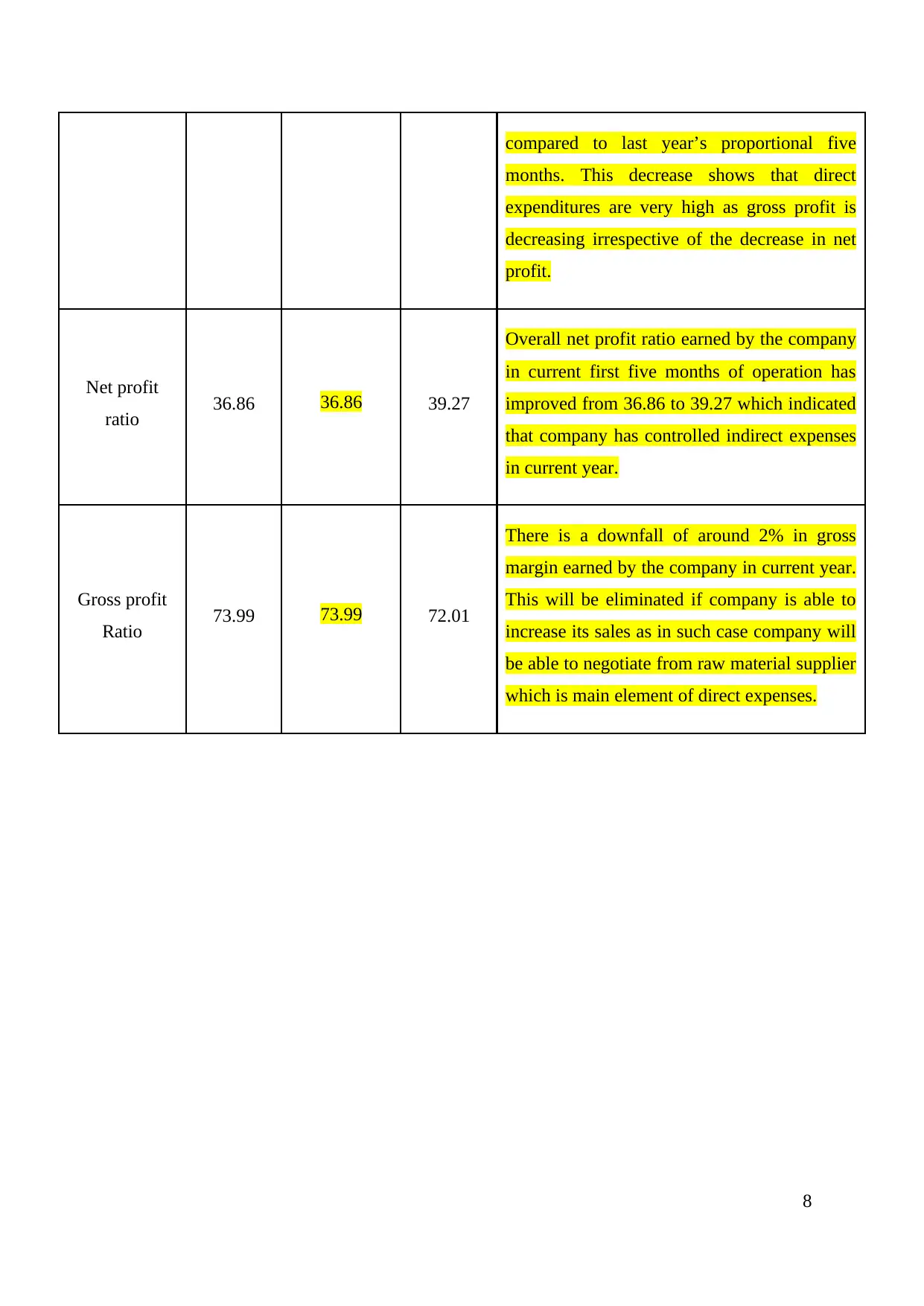
compared to last year’s proportional five
months. This decrease shows that direct
expenditures are very high as gross profit is
decreasing irrespective of the decrease in net
profit.
Net profit
ratio 36.86 36.86 39.27
Overall net profit ratio earned by the company
in current first five months of operation has
improved from 36.86 to 39.27 which indicated
that company has controlled indirect expenses
in current year.
Gross profit
Ratio 73.99 73.99 72.01
There is a downfall of around 2% in gross
margin earned by the company in current year.
This will be eliminated if company is able to
increase its sales as in such case company will
be able to negotiate from raw material supplier
which is main element of direct expenses.
8
months. This decrease shows that direct
expenditures are very high as gross profit is
decreasing irrespective of the decrease in net
profit.
Net profit
ratio 36.86 36.86 39.27
Overall net profit ratio earned by the company
in current first five months of operation has
improved from 36.86 to 39.27 which indicated
that company has controlled indirect expenses
in current year.
Gross profit
Ratio 73.99 73.99 72.01
There is a downfall of around 2% in gross
margin earned by the company in current year.
This will be eliminated if company is able to
increase its sales as in such case company will
be able to negotiate from raw material supplier
which is main element of direct expenses.
8
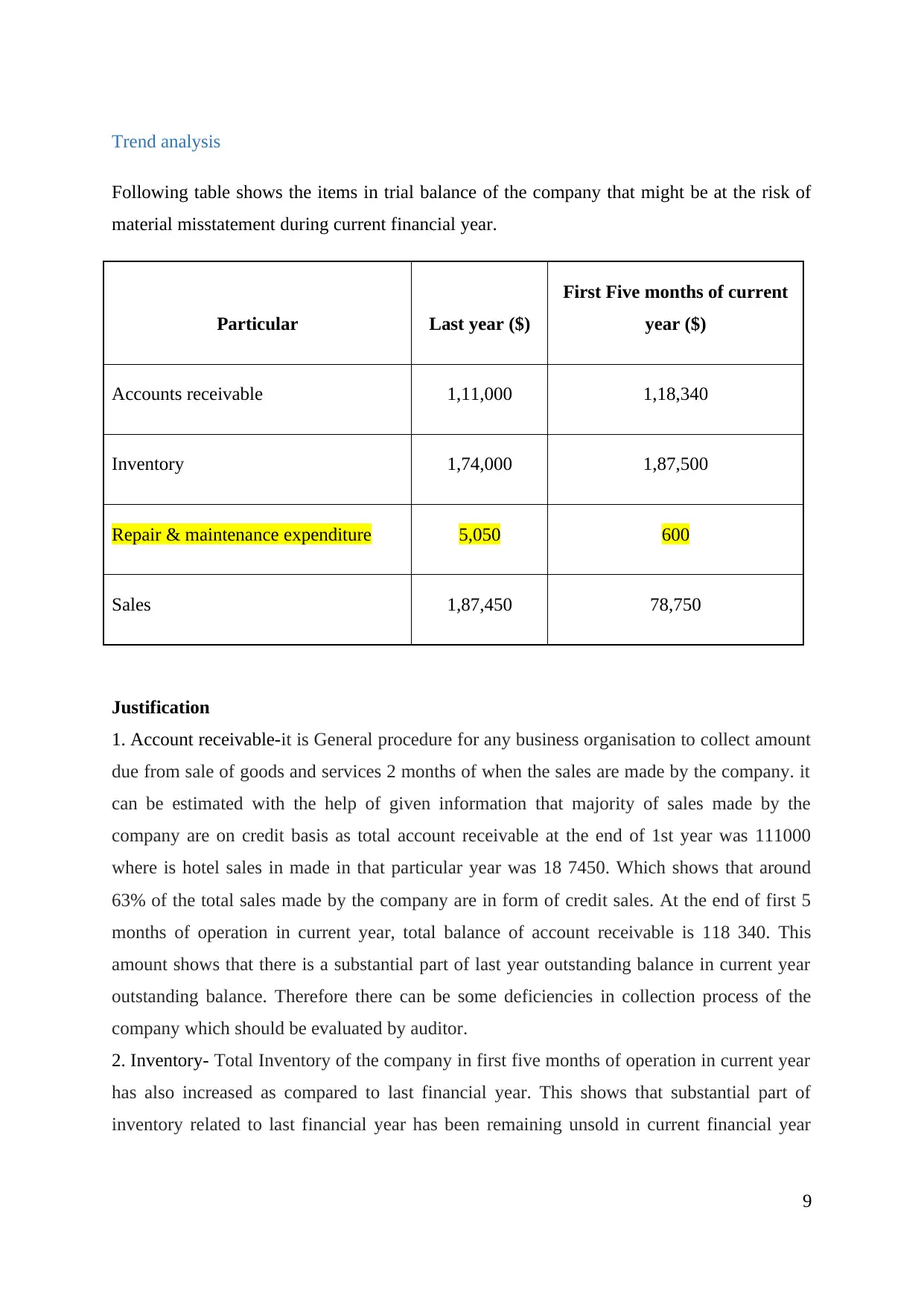
Trend analysis
Following table shows the items in trial balance of the company that might be at the risk of
material misstatement during current financial year.
Particular Last year ($)
First Five months of current
year ($)
Accounts receivable 1,11,000 1,18,340
Inventory 1,74,000 1,87,500
Repair & maintenance expenditure 5,050 600
Sales 1,87,450 78,750
Justification
1. Account receivable-it is General procedure for any business organisation to collect amount
due from sale of goods and services 2 months of when the sales are made by the company. it
can be estimated with the help of given information that majority of sales made by the
company are on credit basis as total account receivable at the end of 1st year was 111000
where is hotel sales in made in that particular year was 18 7450. Which shows that around
63% of the total sales made by the company are in form of credit sales. At the end of first 5
months of operation in current year, total balance of account receivable is 118 340. This
amount shows that there is a substantial part of last year outstanding balance in current year
outstanding balance. Therefore there can be some deficiencies in collection process of the
company which should be evaluated by auditor.
2. Inventory- Total Inventory of the company in first five months of operation in current year
has also increased as compared to last financial year. This shows that substantial part of
inventory related to last financial year has been remaining unsold in current financial year
9
Following table shows the items in trial balance of the company that might be at the risk of
material misstatement during current financial year.
Particular Last year ($)
First Five months of current
year ($)
Accounts receivable 1,11,000 1,18,340
Inventory 1,74,000 1,87,500
Repair & maintenance expenditure 5,050 600
Sales 1,87,450 78,750
Justification
1. Account receivable-it is General procedure for any business organisation to collect amount
due from sale of goods and services 2 months of when the sales are made by the company. it
can be estimated with the help of given information that majority of sales made by the
company are on credit basis as total account receivable at the end of 1st year was 111000
where is hotel sales in made in that particular year was 18 7450. Which shows that around
63% of the total sales made by the company are in form of credit sales. At the end of first 5
months of operation in current year, total balance of account receivable is 118 340. This
amount shows that there is a substantial part of last year outstanding balance in current year
outstanding balance. Therefore there can be some deficiencies in collection process of the
company which should be evaluated by auditor.
2. Inventory- Total Inventory of the company in first five months of operation in current year
has also increased as compared to last financial year. This shows that substantial part of
inventory related to last financial year has been remaining unsold in current financial year
9
⊘ This is a preview!⊘
Do you want full access?
Subscribe today to unlock all pages.

Trusted by 1+ million students worldwide

(Contessotto, C. and Moroney¸2014). It can be a result of deficiency in inventory
management all the company.
3. Repair and maintenance- total repair and maintenance expenditure conducted by the
company are substantially lower as compared to last financial year as it has decreased form
$5050 in last years to just $600 in first five months of operation. In the analytical review of
financial items in trial balance it was also evaluated that total direct expenditure has also
increased in current 5 months. Repairs to machinery and increase in direct expenditure can be
directly related to each other in this scenario. Every machinery involved in the production
process required regular repair and maintenance as it can decrease efficiency of machine
which will ultimately increase direct cost of production.
4. Sales- It can be evaluated that proportional things of the company for 5 months as decrease
the as compared to last financial year but management of the company has purchased new
machinery worth $6000 in current financial year. Generally, increasing capacity of the
company also increasing the sales of the company as main purpose of acquisition of new
machinery is to boost up the sale. Quality of machinery purchased by the company should be
evaluated (Graham, Bedard and Dutta, 2018).
10
management all the company.
3. Repair and maintenance- total repair and maintenance expenditure conducted by the
company are substantially lower as compared to last financial year as it has decreased form
$5050 in last years to just $600 in first five months of operation. In the analytical review of
financial items in trial balance it was also evaluated that total direct expenditure has also
increased in current 5 months. Repairs to machinery and increase in direct expenditure can be
directly related to each other in this scenario. Every machinery involved in the production
process required regular repair and maintenance as it can decrease efficiency of machine
which will ultimately increase direct cost of production.
4. Sales- It can be evaluated that proportional things of the company for 5 months as decrease
the as compared to last financial year but management of the company has purchased new
machinery worth $6000 in current financial year. Generally, increasing capacity of the
company also increasing the sales of the company as main purpose of acquisition of new
machinery is to boost up the sale. Quality of machinery purchased by the company should be
evaluated (Graham, Bedard and Dutta, 2018).
10
Paraphrase This Document
Need a fresh take? Get an instant paraphrase of this document with our AI Paraphraser
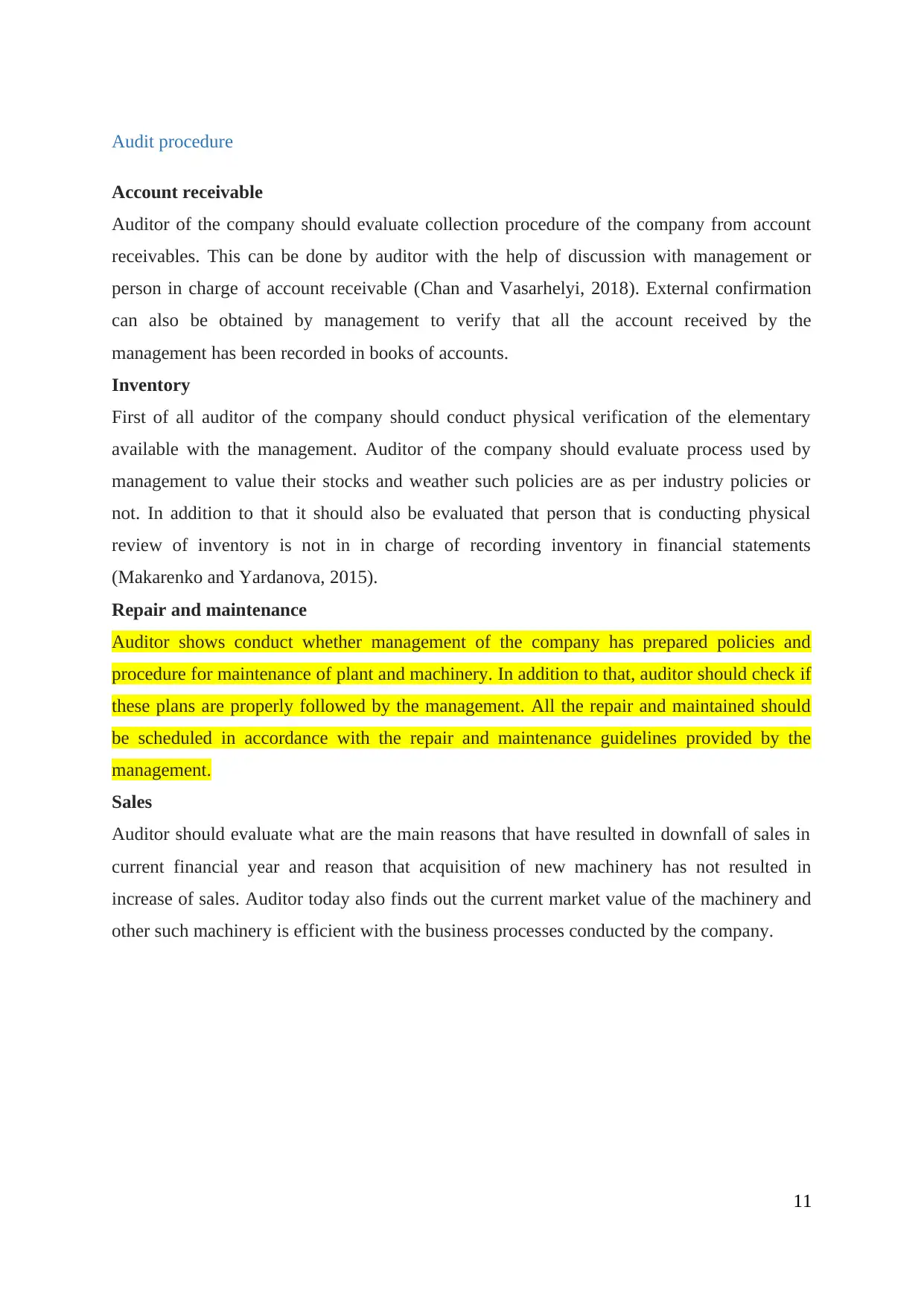
Audit procedure
Account receivable
Auditor of the company should evaluate collection procedure of the company from account
receivables. This can be done by auditor with the help of discussion with management or
person in charge of account receivable (Chan and Vasarhelyi, 2018). External confirmation
can also be obtained by management to verify that all the account received by the
management has been recorded in books of accounts.
Inventory
First of all auditor of the company should conduct physical verification of the elementary
available with the management. Auditor of the company should evaluate process used by
management to value their stocks and weather such policies are as per industry policies or
not. In addition to that it should also be evaluated that person that is conducting physical
review of inventory is not in in charge of recording inventory in financial statements
(Makarenko and Yardanova, 2015).
Repair and maintenance
Auditor shows conduct whether management of the company has prepared policies and
procedure for maintenance of plant and machinery. In addition to that, auditor should check if
these plans are properly followed by the management. All the repair and maintained should
be scheduled in accordance with the repair and maintenance guidelines provided by the
management.
Sales
Auditor should evaluate what are the main reasons that have resulted in downfall of sales in
current financial year and reason that acquisition of new machinery has not resulted in
increase of sales. Auditor today also finds out the current market value of the machinery and
other such machinery is efficient with the business processes conducted by the company.
11
Account receivable
Auditor of the company should evaluate collection procedure of the company from account
receivables. This can be done by auditor with the help of discussion with management or
person in charge of account receivable (Chan and Vasarhelyi, 2018). External confirmation
can also be obtained by management to verify that all the account received by the
management has been recorded in books of accounts.
Inventory
First of all auditor of the company should conduct physical verification of the elementary
available with the management. Auditor of the company should evaluate process used by
management to value their stocks and weather such policies are as per industry policies or
not. In addition to that it should also be evaluated that person that is conducting physical
review of inventory is not in in charge of recording inventory in financial statements
(Makarenko and Yardanova, 2015).
Repair and maintenance
Auditor shows conduct whether management of the company has prepared policies and
procedure for maintenance of plant and machinery. In addition to that, auditor should check if
these plans are properly followed by the management. All the repair and maintained should
be scheduled in accordance with the repair and maintenance guidelines provided by the
management.
Sales
Auditor should evaluate what are the main reasons that have resulted in downfall of sales in
current financial year and reason that acquisition of new machinery has not resulted in
increase of sales. Auditor today also finds out the current market value of the machinery and
other such machinery is efficient with the business processes conducted by the company.
11
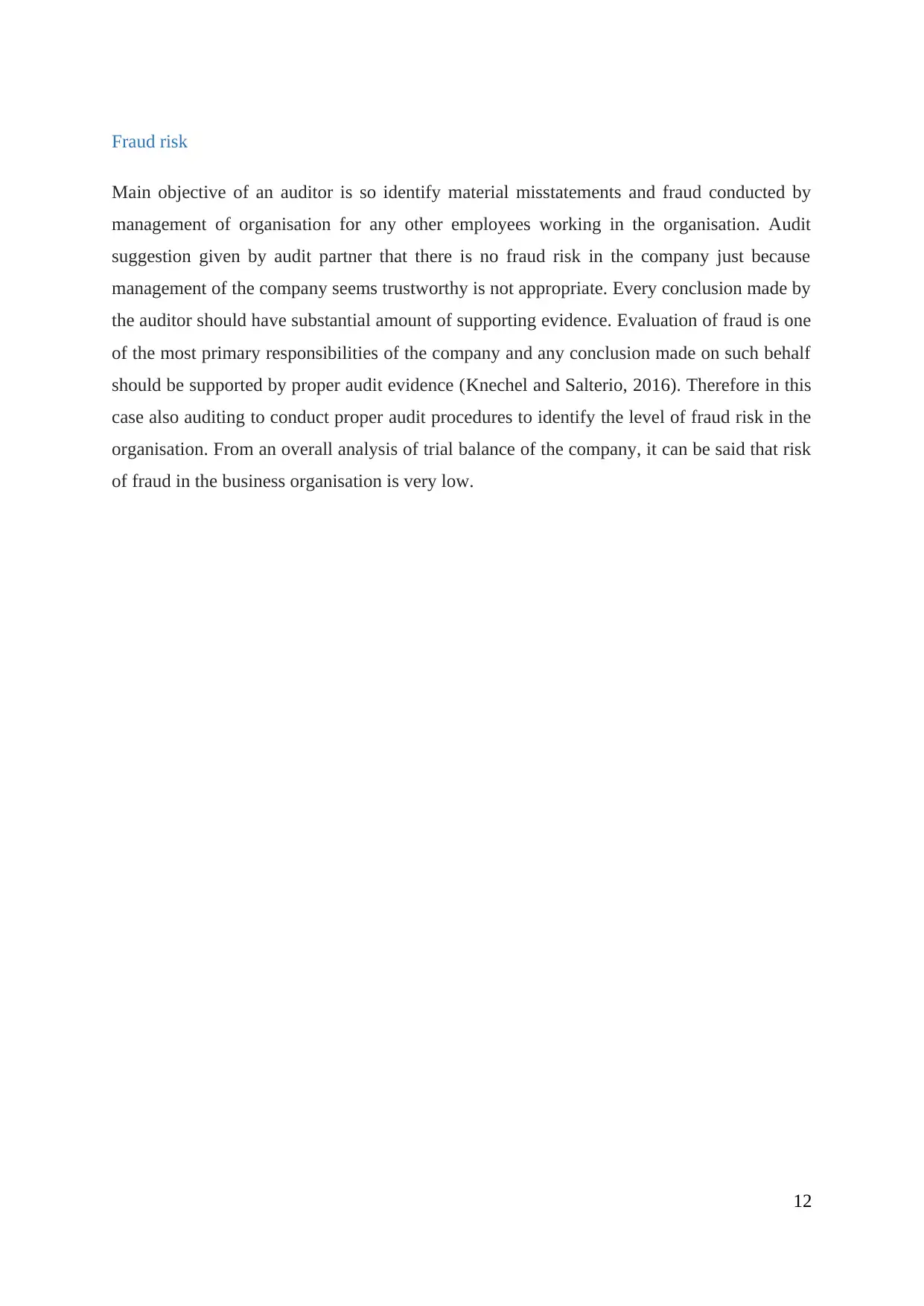
Fraud risk
Main objective of an auditor is so identify material misstatements and fraud conducted by
management of organisation for any other employees working in the organisation. Audit
suggestion given by audit partner that there is no fraud risk in the company just because
management of the company seems trustworthy is not appropriate. Every conclusion made by
the auditor should have substantial amount of supporting evidence. Evaluation of fraud is one
of the most primary responsibilities of the company and any conclusion made on such behalf
should be supported by proper audit evidence (Knechel and Salterio, 2016). Therefore in this
case also auditing to conduct proper audit procedures to identify the level of fraud risk in the
organisation. From an overall analysis of trial balance of the company, it can be said that risk
of fraud in the business organisation is very low.
12
Main objective of an auditor is so identify material misstatements and fraud conducted by
management of organisation for any other employees working in the organisation. Audit
suggestion given by audit partner that there is no fraud risk in the company just because
management of the company seems trustworthy is not appropriate. Every conclusion made by
the auditor should have substantial amount of supporting evidence. Evaluation of fraud is one
of the most primary responsibilities of the company and any conclusion made on such behalf
should be supported by proper audit evidence (Knechel and Salterio, 2016). Therefore in this
case also auditing to conduct proper audit procedures to identify the level of fraud risk in the
organisation. From an overall analysis of trial balance of the company, it can be said that risk
of fraud in the business organisation is very low.
12
⊘ This is a preview!⊘
Do you want full access?
Subscribe today to unlock all pages.

Trusted by 1+ million students worldwide
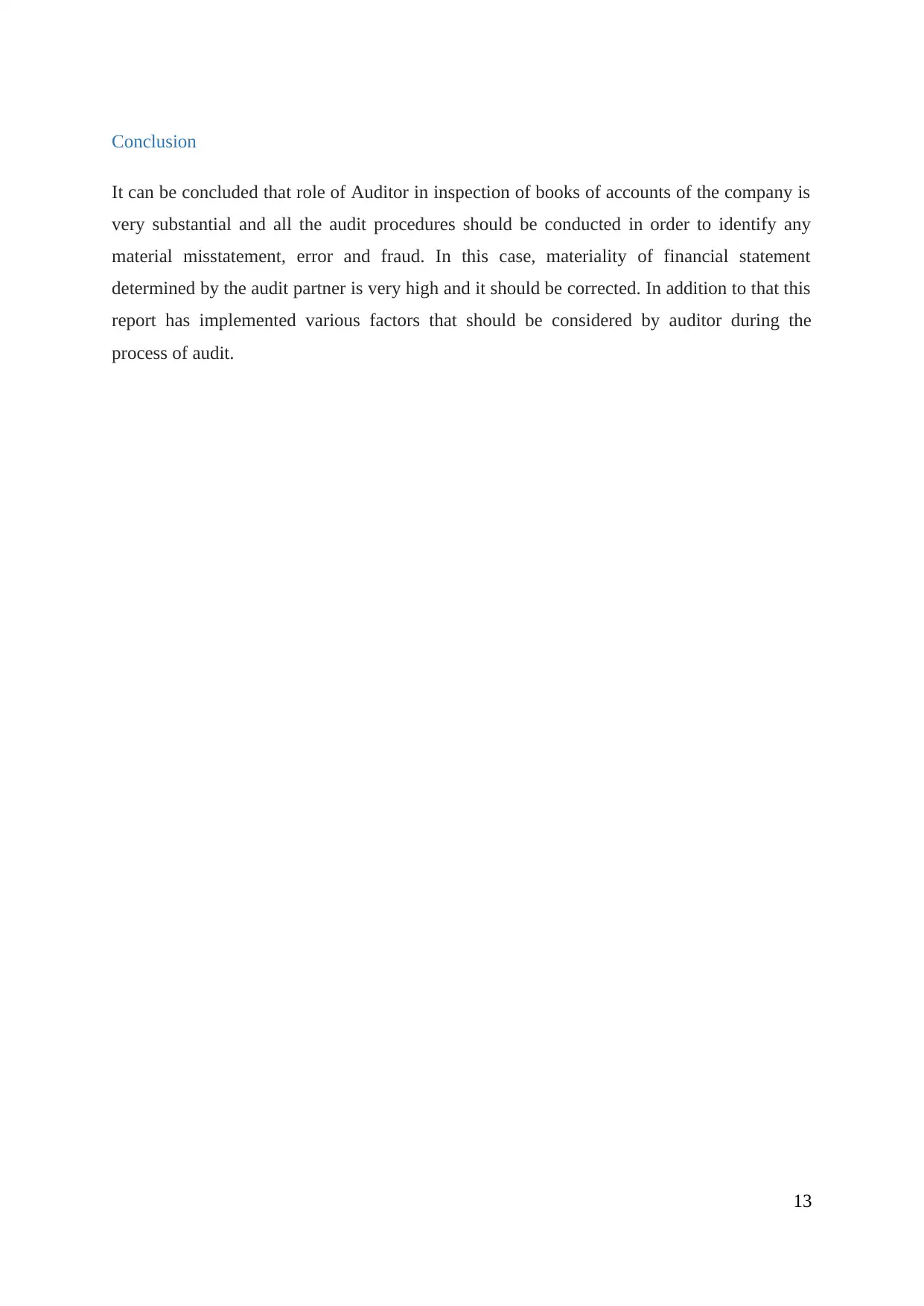
Conclusion
It can be concluded that role of Auditor in inspection of books of accounts of the company is
very substantial and all the audit procedures should be conducted in order to identify any
material misstatement, error and fraud. In this case, materiality of financial statement
determined by the audit partner is very high and it should be corrected. In addition to that this
report has implemented various factors that should be considered by auditor during the
process of audit.
13
It can be concluded that role of Auditor in inspection of books of accounts of the company is
very substantial and all the audit procedures should be conducted in order to identify any
material misstatement, error and fraud. In this case, materiality of financial statement
determined by the audit partner is very high and it should be corrected. In addition to that this
report has implemented various factors that should be considered by auditor during the
process of audit.
13
Paraphrase This Document
Need a fresh take? Get an instant paraphrase of this document with our AI Paraphraser
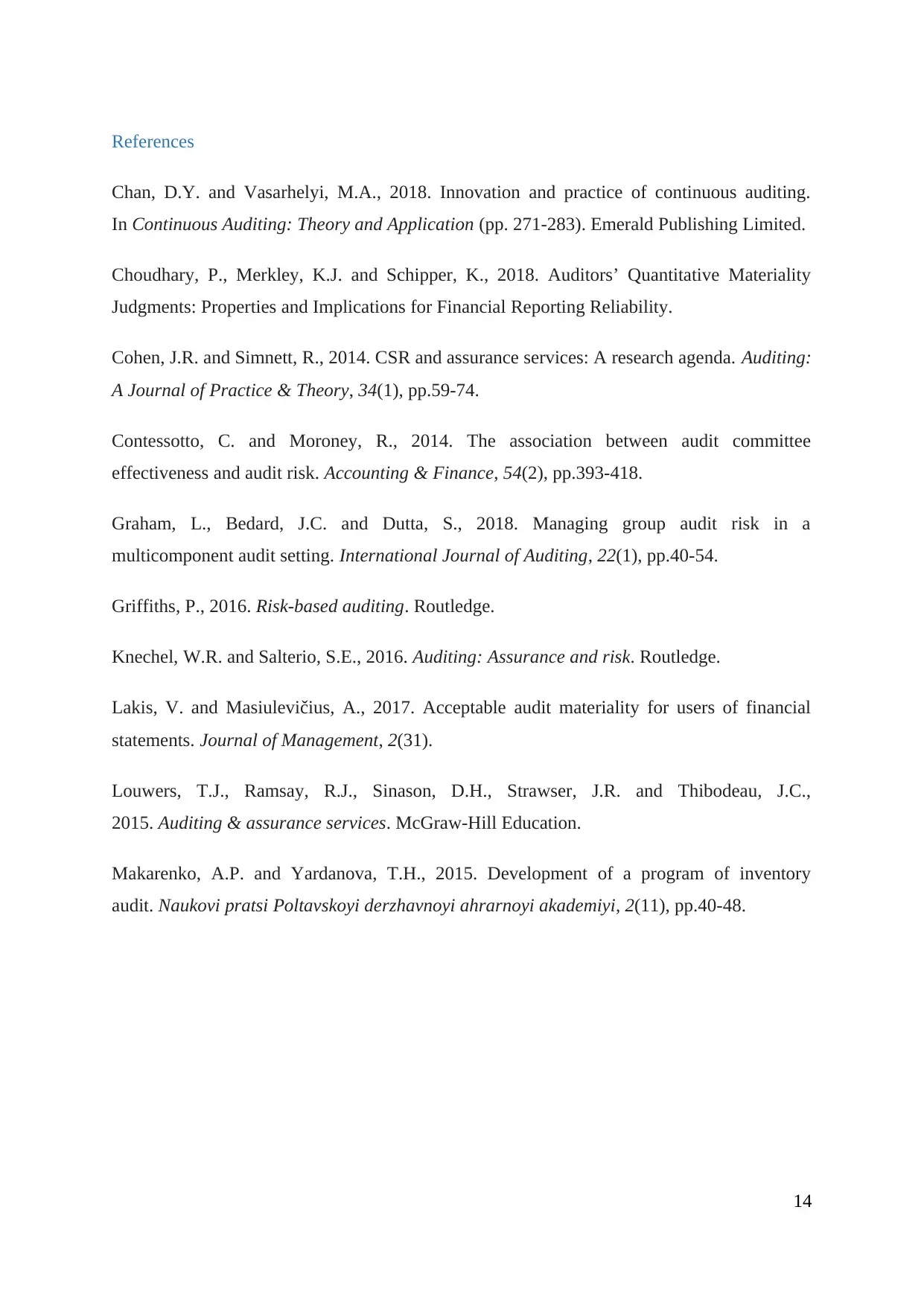
References
Chan, D.Y. and Vasarhelyi, M.A., 2018. Innovation and practice of continuous auditing.
In Continuous Auditing: Theory and Application (pp. 271-283). Emerald Publishing Limited.
Choudhary, P., Merkley, K.J. and Schipper, K., 2018. Auditors’ Quantitative Materiality
Judgments: Properties and Implications for Financial Reporting Reliability.
Cohen, J.R. and Simnett, R., 2014. CSR and assurance services: A research agenda. Auditing:
A Journal of Practice & Theory, 34(1), pp.59-74.
Contessotto, C. and Moroney, R., 2014. The association between audit committee
effectiveness and audit risk. Accounting & Finance, 54(2), pp.393-418.
Graham, L., Bedard, J.C. and Dutta, S., 2018. Managing group audit risk in a
multicomponent audit setting. International Journal of Auditing, 22(1), pp.40-54.
Griffiths, P., 2016. Risk-based auditing. Routledge.
Knechel, W.R. and Salterio, S.E., 2016. Auditing: Assurance and risk. Routledge.
Lakis, V. and Masiulevičius, A., 2017. Acceptable audit materiality for users of financial
statements. Journal of Management, 2(31).
Louwers, T.J., Ramsay, R.J., Sinason, D.H., Strawser, J.R. and Thibodeau, J.C.,
2015. Auditing & assurance services. McGraw-Hill Education.
Makarenko, A.P. and Yardanova, T.H., 2015. Development of a program of inventory
audit. Naukovi pratsi Poltavskoyi derzhavnoyi ahrarnoyi akademiyi, 2(11), pp.40-48.
14
Chan, D.Y. and Vasarhelyi, M.A., 2018. Innovation and practice of continuous auditing.
In Continuous Auditing: Theory and Application (pp. 271-283). Emerald Publishing Limited.
Choudhary, P., Merkley, K.J. and Schipper, K., 2018. Auditors’ Quantitative Materiality
Judgments: Properties and Implications for Financial Reporting Reliability.
Cohen, J.R. and Simnett, R., 2014. CSR and assurance services: A research agenda. Auditing:
A Journal of Practice & Theory, 34(1), pp.59-74.
Contessotto, C. and Moroney, R., 2014. The association between audit committee
effectiveness and audit risk. Accounting & Finance, 54(2), pp.393-418.
Graham, L., Bedard, J.C. and Dutta, S., 2018. Managing group audit risk in a
multicomponent audit setting. International Journal of Auditing, 22(1), pp.40-54.
Griffiths, P., 2016. Risk-based auditing. Routledge.
Knechel, W.R. and Salterio, S.E., 2016. Auditing: Assurance and risk. Routledge.
Lakis, V. and Masiulevičius, A., 2017. Acceptable audit materiality for users of financial
statements. Journal of Management, 2(31).
Louwers, T.J., Ramsay, R.J., Sinason, D.H., Strawser, J.R. and Thibodeau, J.C.,
2015. Auditing & assurance services. McGraw-Hill Education.
Makarenko, A.P. and Yardanova, T.H., 2015. Development of a program of inventory
audit. Naukovi pratsi Poltavskoyi derzhavnoyi ahrarnoyi akademiyi, 2(11), pp.40-48.
14
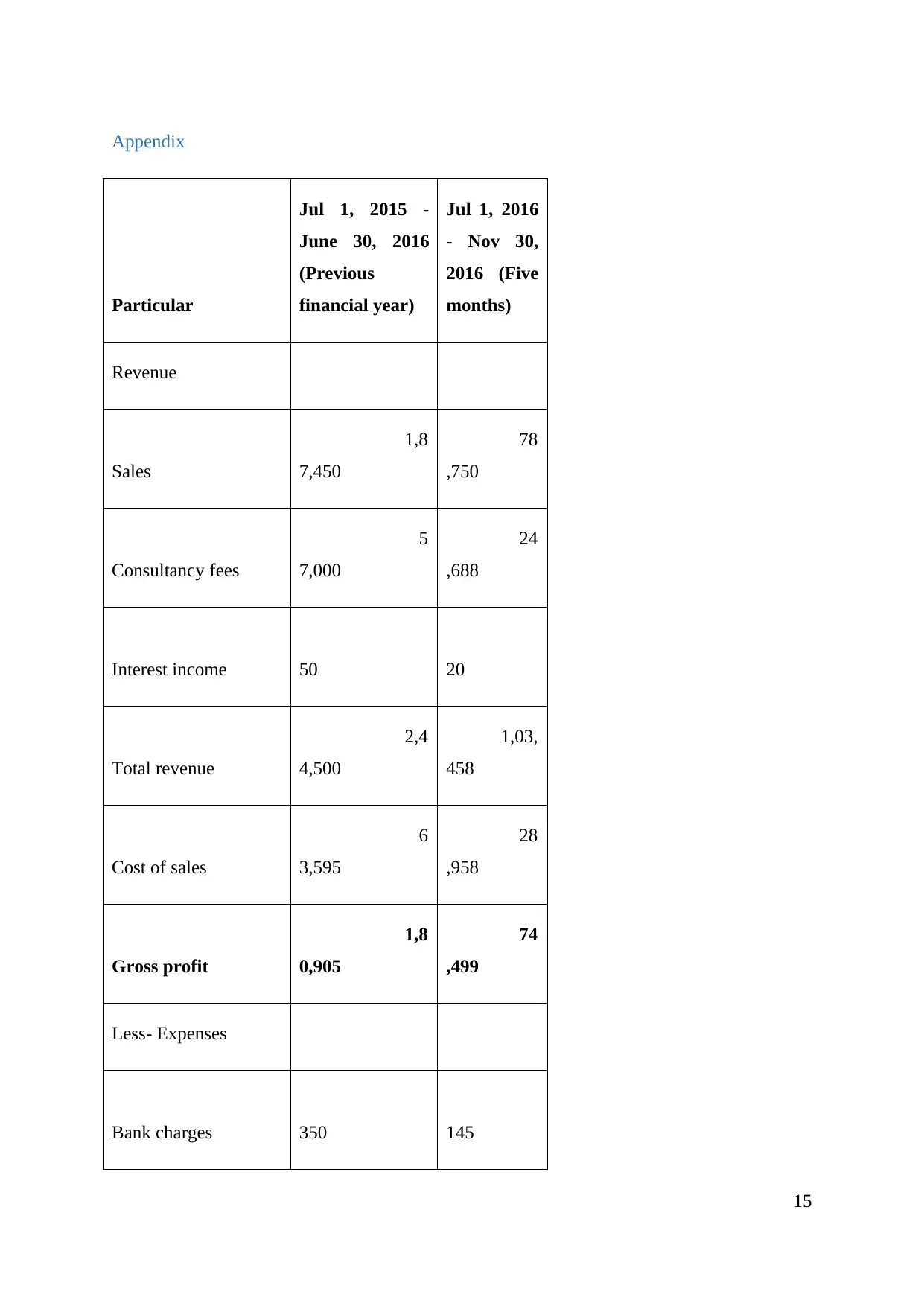
Appendix
Particular
Jul 1, 2015 -
June 30, 2016
(Previous
financial year)
Jul 1, 2016
- Nov 30,
2016 (Five
months)
Revenue
Sales
1,8
7,450
78
,750
Consultancy fees
5
7,000
24
,688
Interest income 50 20
Total revenue
2,4
4,500
1,03,
458
Cost of sales
6
3,595
28
,958
Gross profit
1,8
0,905
74
,499
Less- Expenses
Bank charges 350 145
15
Particular
Jul 1, 2015 -
June 30, 2016
(Previous
financial year)
Jul 1, 2016
- Nov 30,
2016 (Five
months)
Revenue
Sales
1,8
7,450
78
,750
Consultancy fees
5
7,000
24
,688
Interest income 50 20
Total revenue
2,4
4,500
1,03,
458
Cost of sales
6
3,595
28
,958
Gross profit
1,8
0,905
74
,499
Less- Expenses
Bank charges 350 145
15
⊘ This is a preview!⊘
Do you want full access?
Subscribe today to unlock all pages.

Trusted by 1+ million students worldwide
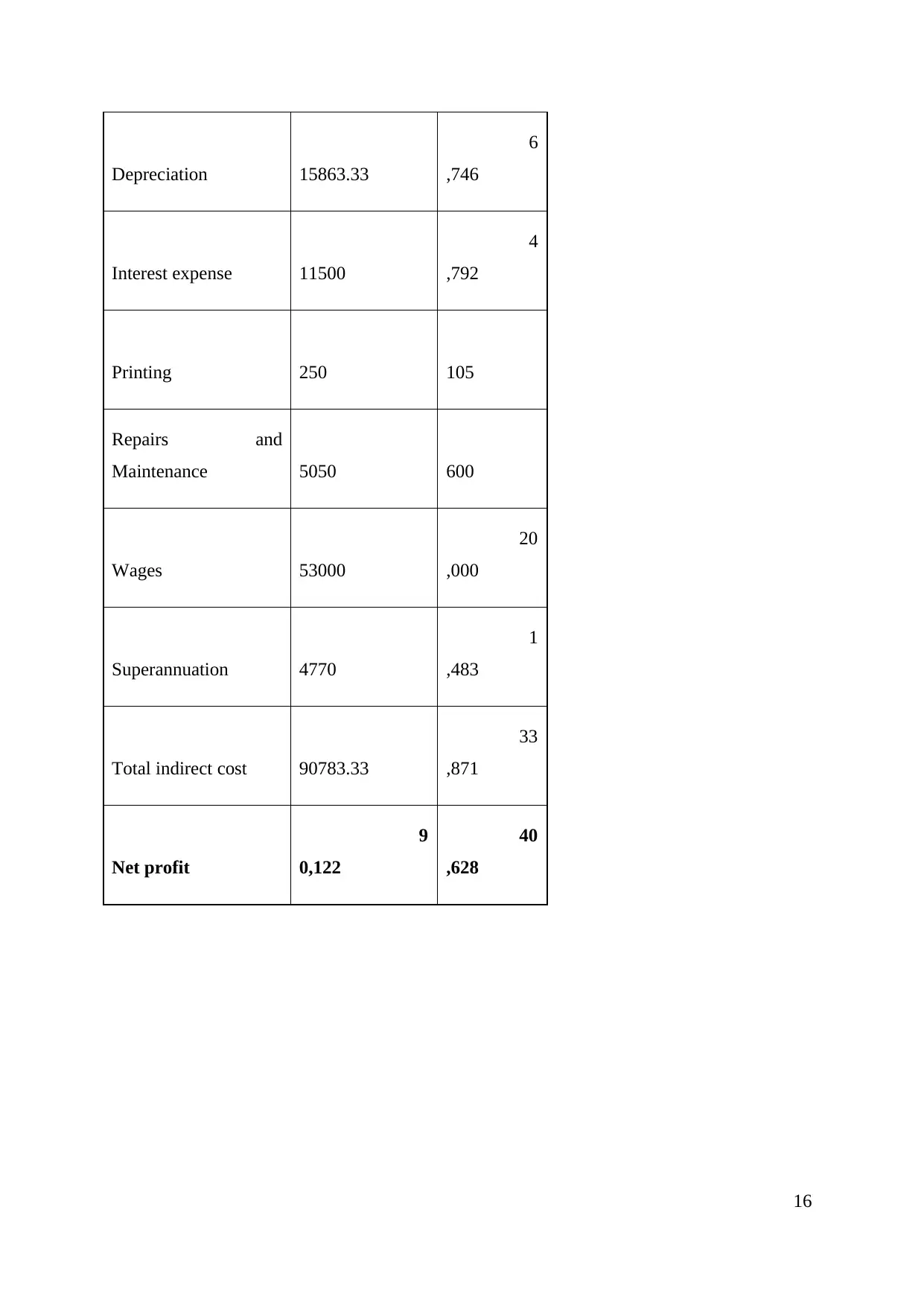
Depreciation 15863.33
6
,746
Interest expense 11500
4
,792
Printing 250 105
Repairs and
Maintenance 5050 600
Wages 53000
20
,000
Superannuation 4770
1
,483
Total indirect cost 90783.33
33
,871
Net profit
9
0,122
40
,628
16
6
,746
Interest expense 11500
4
,792
Printing 250 105
Repairs and
Maintenance 5050 600
Wages 53000
20
,000
Superannuation 4770
1
,483
Total indirect cost 90783.33
33
,871
Net profit
9
0,122
40
,628
16
1 out of 16
Related Documents
Your All-in-One AI-Powered Toolkit for Academic Success.
+13062052269
info@desklib.com
Available 24*7 on WhatsApp / Email
![[object Object]](/_next/static/media/star-bottom.7253800d.svg)
Unlock your academic potential
© 2024 | Zucol Services PVT LTD | All rights reserved.


